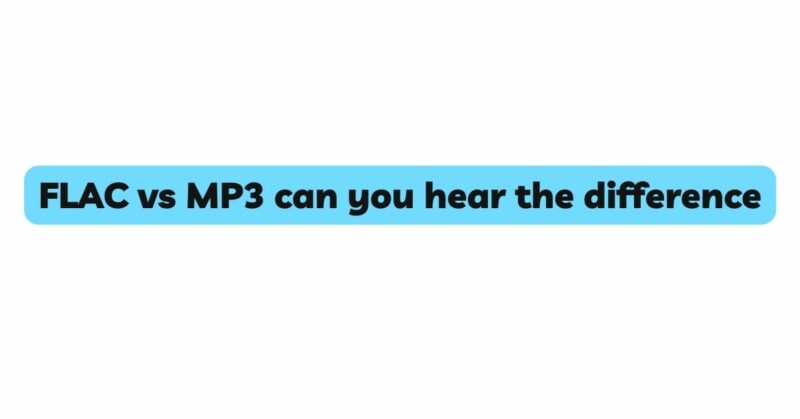In the realm of digital audio formats, the perennial clash between FLAC (Free Lossless Audio Codec) and MP3 (MPEG Audio Layer III) has become emblematic of the ongoing quest for sonic perfection. Central to this debate is the question that has intrigued audiophiles and music enthusiasts for years: Can you hear the difference between FLAC and MP3? This article undertakes a comprehensive exploration, delving into the technical foundations, perceptual nuances, psychological biases, and real-world implications of these two formats.
Decoding the Formats: FLAC and MP3
Before delving into their auditory distinctions, it’s crucial to grasp the fundamental attributes of FLAC and MP3. FLAC employs lossless compression, meticulously preserving every detail of the original audio source. This results in uncompromised audio quality, making FLAC a preferred choice among audiophiles and professionals. MP3, conversely, employs lossy compression, sacrificing some audio data to achieve smaller file sizes while aiming to maintain perceptible sound quality.
Objective Measures: Bit Rates and Audio Quality
An essential component in understanding the FLAC vs MP3 debate lies in the concept of bit rates. Bit rates indicate the amount of data allocated to represent audio information in a file. FLAC’s lossless nature permits flexibility in bit rates, ensuring that no detail is compromised. MP3’s bit rates, however, are often constant, varying only in terms of the degree of lossy compression applied.
Perceptual Differences: Audiophiles and the Average Listener
The perceptual differences between FLAC and MP3 hinge on the listener’s auditory acuity, the quality of playback equipment, and the listening environment. Audiophiles, who possess well-trained ears and high-end audio systems, may be able to detect subtle nuances present in FLAC files. Controlled listening tests have shown that trained listeners can identify these differences under controlled conditions. However, the extent of these differences in real-world listening scenarios varies widely.
For the average listener, the perceptible distinctions between FLAC and MP3 might be less pronounced. Consumer-grade headphones, portable devices, and ambient noise can all contribute to a diminished ability to detect subtle audio nuances. This raises the question of whether the perceived benefits of FLAC extend to everyday listening environments.
The Psychology of Expectation Bias
Human perception of audio quality is not solely based on objective measures; psychological factors play a significant role. The phenomenon of expectation bias can heavily influence the perception of audio quality. If listeners are aware of the file format beforehand and hold preconceived notions about the superiority of FLAC, their bias might lead them to perceive FLAC as sounding better, even if the actual differences are minimal.
Real-World Listening Environments: Considerations and Constraints
In the age of music streaming, the practical implications of audio formats take center stage. FLAC’s lossless compression results in larger file sizes compared to MP3, which can be a concern for those with limited storage capacity. Additionally, streaming platforms often prioritize efficient data transmission, leading to a preference for formats like MP3 that strike a balance between quality and size.
Furthermore, factors such as the quality of internet connections, device compatibility, and the diversity of listening scenarios further complicate the perceived differences between FLAC and MP3. While FLAC’s fidelity might shine in controlled listening tests, its superiority might be less evident in the complex tapestry of real-world environments.
Closing the Gap: Technological Advancements
Advancements in audio encoding technologies have narrowed the gap between FLAC and high-bit rate MP3 files. Modern MP3 codecs, such as LAME MP3 and AAC, offer improved audio quality, making the differences between FLAC and high-bit rate MP3 less conspicuous, especially for the average listener.
Conclusion: The Melody of Personal Preference
The question of whether you can hear the difference between FLAC and MP3 encapsulates the intricate interplay between technology, psychology, and individual perception. Audiophiles with discerning ears and optimal listening setups might revel in the nuanced fidelity of FLAC. Yet, for most listeners in everyday contexts, the disparities between FLAC and MP3 might be less significant than expected.
Ultimately, the choice between FLAC and MP3 rests on personal priorities and practical considerations. Audiophiles and professionals might continue to appreciate the meticulous preservation of audio in FLAC. However, for the majority of music enthusiasts, high-bit rate MP3 files might strike an optimal balance between storage efficiency and perceptible audio quality.
The FLAC vs MP3 debate embodies the ever-evolving nature of technology and the subjectivity of human perception. As we continue to embrace the evolving soundscape, the enduring question of whether one can truly hear the difference between FLAC and MP3 will remain a sonic enigma that fuels discussions, reflections, and the art of experiencing music.


